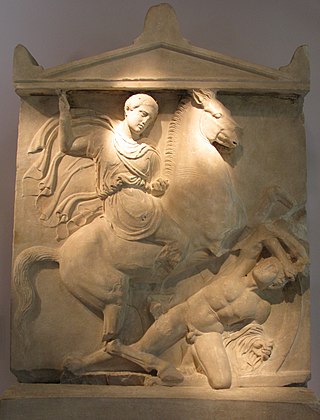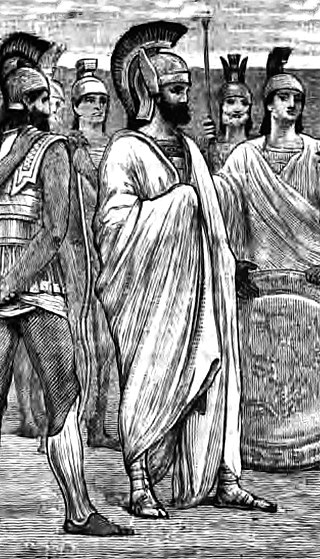Year 431 BC was a year of the pre-Julian Roman calendar. At the time, to Romans it was known as the Year of the Consulship of Cincinnatus and Mento. The denomination 431 BC for this year has been used since the early medieval period, when the Anno Domini calendar era became the prevalent method in Europe for naming years.
This article concerns the period 379 BC – 370 BC.
This article concerns the period 389 BC – 380 BC.

This is a timeline of ancient Greece from its emergence around 800 BC to its subjection to the Roman Empire in 146 BC.
Year 395 BC was a year of the pre-Julian Roman calendar. At the time, it was known as the Year of the Tribunate of Cossus, Medullinus, Scipio, Fidenas, Ambustus and Lactucinus. The denomination 395 BC for this year has been used since the early medieval period, when the Anno Domini calendar era became the prevalent method in Europe for naming years.

Thebes is a city in Boeotia, Central Greece, and is one of the oldest continuously inhabited cities in the world. It is the largest city in Boeotia and a major center for the area along with Livadeia and Tanagra.
Year 457 BC was a year of the pre-Julian Roman calendar. At the time, it was known as the Year of the Consulship of Pulvillus and Augurinus or Cincinnatus and Vibulanus. The denomination 457 BC for this year has been used since the early medieval period, when the Anno Domini calendar era became the prevalent method in Europe for naming years.
Year 379 BC was a year of the pre-Julian Roman calendar. At the time, it was known as the Year of the Tribunate of Capitolinus, Vulso, Iullus, Sextilius, Albinius, Antistius, Trebonius and Erenucius. The denomination 379 BC for this year has been used since the early medieval period, when the Anno Domini calendar era became the prevalent method in Europe for naming years.
Year 377 BC was a year of the pre-Julian Roman calendar. At the time, it was known as the Year of the Tribunate of Mamercinus, Poplicola, Cicurinus, Rufus, Cincinnatus and Cincinnatus. The denomination 377 BC for this year has been used since the early medieval period, when the Anno Domini calendar era became the prevalent method in Europe for naming years.

Year 371 BC was a year of the pre-Julian Roman calendar. At the time, it was known as the Fifth year without Tribunate or Consulship. The denomination 371 BC for this year has been used since the early medieval period, when the Anno Domini calendar era became the prevalent method in Europe for naming years.

The King's Peace was a peace treaty guaranteed by the Persian King Artaxerxes II that ended the Corinthian War in ancient Greece. The treaty is also known as the Peace of Antalcidas, after Antalcidas, the Spartan diplomat who traveled to Susa to negotiate the terms of the treaty with the king of Achaemenid Persia. The treaty was more commonly known in antiquity, however, as the King's Peace, a name that reflects the depth of Persian influence in the treaty, as Persian gold had driven the preceding war. The treaty was a form of Common Peace, similar to the Thirty Years' Peace which ended the First Peloponnesian War.

Epaminondas was a Greek general and statesman of the 4th century BC who transformed the Ancient Greek city-state of Thebes, leading it out of Spartan subjugation into a pre-eminent position in Greek politics called the Theban Hegemony. In the process, he broke Spartan military power with his victory at Leuctra and liberated the Messenian helots, a group of Peloponnesian Greeks who had been enslaved under Spartan rule for some 230 years following their defeat in the Third Messenian War ending in 600 BC. Epaminondas reshaped the political map of Greece, fragmented old alliances, created new ones, and supervised the construction of entire cities. He was also militarily influential and invented and implemented several important battlefield tactics.

The Corinthian War was a conflict in ancient Greece which pitted Sparta against a coalition of city-states comprising Thebes, Athens, Corinth and Argos, backed by the Achaemenid Empire. The war was caused by dissatisfaction with Spartan imperialism in the aftermath of the Peloponnesian War, both from Athens, the defeated side in that conflict, and from Sparta's former allies, Corinth and Thebes, who had not been properly rewarded. Taking advantage of the fact that the Spartan king Agesilaus II was away campaigning in Asia against the Achaemenid Empire, Thebes, Athens, Corinth and Argos forged an alliance in 395 BC with the goal of ending Spartan hegemony over Greece; the allies' war council was located in Corinth, which gave its name to the war. By the end of the conflict, the allies had failed to end Spartan hegemony over Greece, although Sparta was weakened by the war.

The Cadmea, or Cadmeia, was the citadel of ancient Thebes, Greece, which was named after Cadmus, the legendary founder of Thebes. The area is thought to have been settled since at least the early Bronze Age, although the history of settlement can only be reliably dated from the late Mycenaean period.
The Arcadian League was a league of city-states in ancient Greece. It combined the various cities of Arcadia, in the Peloponnese, into a single state. The league was founded in 370 BC, taking advantage of the decreased power of Sparta, which had previously dominated and controlled Arcadia. Mantinea, a city that had suffered under Spartan dominance, was particularly prominent in pushing for its founding. The league was responsible for the foundation of Megalopolis.

The Second Athenian League was a maritime confederation of Greek city-states that existed from 378 to 355 BC under the leadership (hegemony) of Athens. The alliance represented a partial revival of the Delian League, which had been disbanded in 404 BC following the defeat of Athens in the Peloponnesian War. The new League was centered in the Aegean and included over 60 states, among which were Kos, Mytilene, Rhodes, and Byzantium. It was primarily formed as a defensive alliance against Sparta and secondly the Persian Empire. The new League's main objective was to preserve peace in Greece and counterbalance Sparta's growing hegemony and aggression. The League largely revived Athenian influence in the Greek world, reestablishing it as the strongest naval power in the eastern Mediterranean. This time, Athens made conscious efforts to avoid the strict terms that had eventually rendered the previous Delian League unpopular. The alliance lasted until 355 BC, when most of the allied cities became independent following the Social War that broke out in 357 BC.

Classical Greece was a period of around 200 years in Ancient Greece, marked by much of the eastern Aegean and northern regions of Greek culture gaining increased autonomy from the Persian Empire; the peak flourishing of democratic Athens; the First and Second Peloponnesian Wars; the Spartan and then Theban hegemonies; and the expansion of Macedonia under Philip II. Much of the early defining mathematics, science, artistic thought, theatre, literature, philosophy, and politics of Western civilization derives from this period of Greek history, which had a powerful influence on the later Roman Empire. Part of the broader era of classical antiquity, the classical Greek era ended after Philip II's unification of most of the Greek world against the common enemy of the Persian Empire, which was conquered within 13 years during the wars of Alexander the Great, Philip's son.
The Boeotian War broke out in 378 BC as the result of a revolt in Thebes against Sparta. The war saw Thebes become dominant in the Greek World at the expense of Sparta. However, by the end of the war Thebes’ greatest leaders, Pelopidas and Epaminondas, were both dead and Thebes power already waning, allowing for the rise of Macedon.

The Theban–Spartan War of 378–362 BC was a series of military conflicts fought between Sparta and Thebes for hegemony over Greece. Sparta had emerged victorious from the Peloponnesian War against Athens, and occupied a hegemonic position over Greece. However, the Spartans' violent interventionism upset their former allies, especially Thebes and Corinth. The resulting Corinthian War ended with a difficult Spartan victory, but the Boeotian League headed by Thebes was also disbanded.

The First Olynthian War involved Sparta, Macedonia and their allies in conflict with the cities of the Chalcidian League, led by Olynthus. The reasons were, firstly, the strengthening of the Chalcidian League led by Olynthus, which created a threat to Macedonia, and secondly, the desire of Sparta to establish its dominance in Northern Greece.










